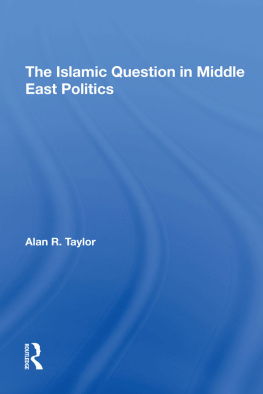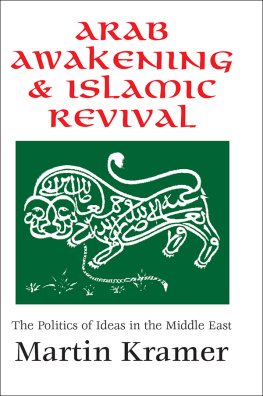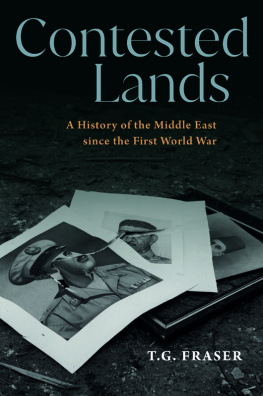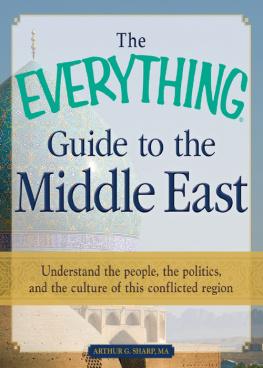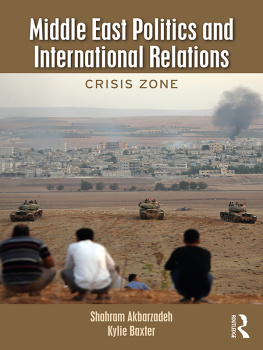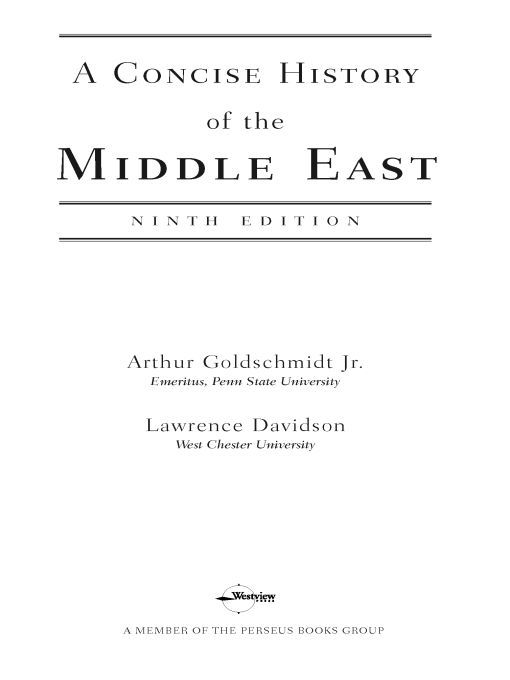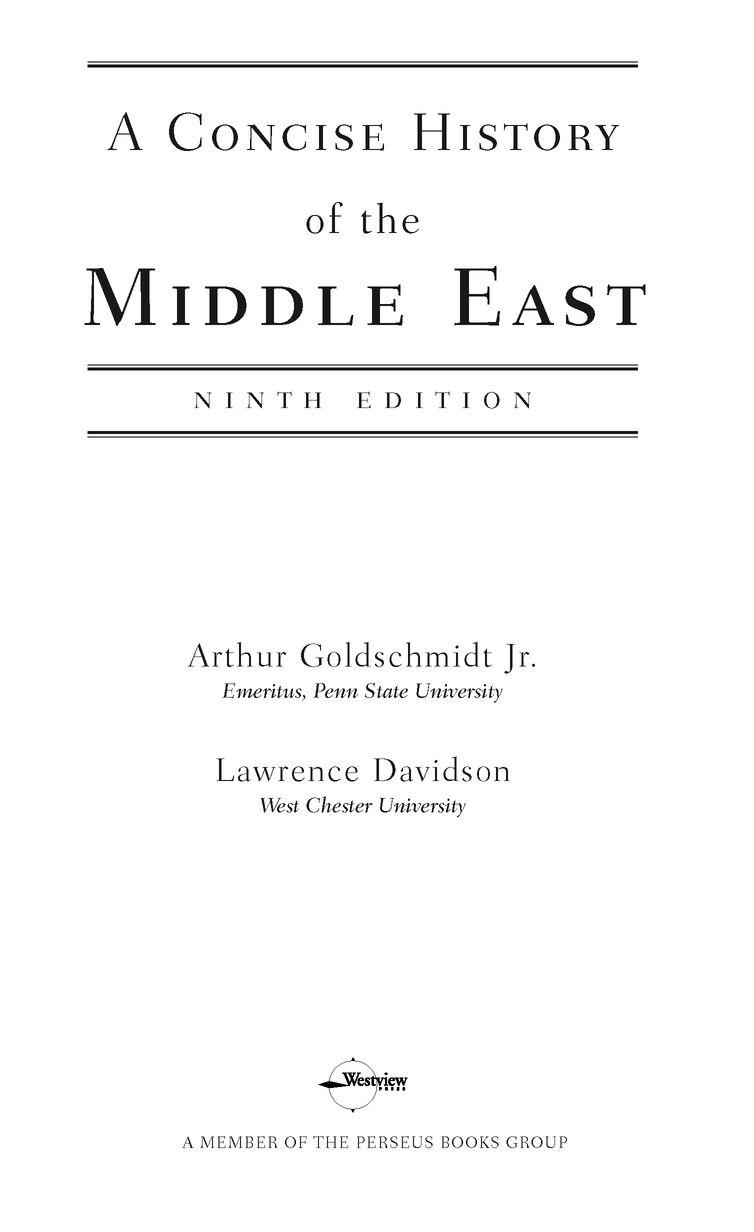Table of Contents
Table of Figures
To the memory of
Agnes Inglis ONeill
teacher, counselor, friend.
She taught every subject with a spirit of fun
and each pupil in a spirit of love.
And to the memory of
Henry Blumenthal
an inspiring teacher and wise adviser,
and of Humphry Osmond,
modern renaissance man and correspondent extraordinaire.
PREFACE TO THE NINTH EDITION
This textbook, sometimes called classic, is now coauthored by Arthur Goldschmidt, who has retired from teaching, and Lawrence Davidson, professor of history at West Chester University. The previous edition was facetiously titled A Decreasingly Concise History of the Middle East. This time, with the advice and help of Karl Yambert, our editor, we have pruned our account wherever we could, even as new events and trends had to be added.
Teachers and students need a book that reflects current scholarship, does not hide its ideas behind a pseudoscholarly style addressed to pedants, and does not reinforce political or ethnic biases. Studentsand members of the wider English-speaking publicdeserve clear explanations of the Arab-Israeli conflict, the Middle Easts role in the energy crisis, the Islamic resurgence, and the war in Iraq. The book has gone through eight previous editions and, despite the appearance of other general histories, has become ever more widely used in universities.
More and more scholars, both Middle Eastern and Western, are enlarging what we know about the history of the area. We canand we mustshare their findings with university students, both to arouse their interest in the Middle East and to make them more aware of themselves by exposure to other lifestyles, other areas, and other eras. Teachers and textbooks cannot free themselves from bias, but both authors want to make sure our students see more than one side of the burning issues of the present and the past. Let us also reveal what we know to the wider public. Many peoplenot only studentscare about what is going on now in the Middle East and how things came to be that way.
Any work of art or scholarship follows conventions. When writing a book that introduces a recondite subject to students and general readers, its authors must tell the audience what these conventions will be. The English system of weights and measures is giving way to the metric system; this book uses both. Prices expressed in non-American currencies, ancient or modern, are given in 2008 US dollar equivalents. All dates are based on the Gregorian calendar. But let no one forget that Muslims follow a twelve-month lunar calendar dated from the year Muhammad and his associates moved from Mecca to Medina. Quite naturally, they use this calendar when they teach or learn Islamic history. Conversion between the two systems is cumbersome and prone to error. When dates appear in parentheses following a rulers name, they refer to the span of his or her reign. Personal names in languages using the Arabic script are transliterated according to International Journal of Middle East Studies system, minus the diacritics, except for a few persons and places mentioned often in the press. The same applies to a few technical terms that cannot be translated simply and accurately into English.
Our wives, Louise Goldschmidt and Janet Amighi, deserve special acknowledgment for their encouragement, patience, advice, and love. Walker Yeatman, a Penn State student, read the whole manuscript and corrected some errors. We remain accountable for all errors of fact or interpretation. We welcome readers comments and advice. The Internet and the word processor have made it easy to revise this book. When we can reach one another through cyberspace, textbook writing can at last be like letter writing. This comes close to the way this textbook was first written, as a series of personal letters addressed to an imaginary student. If you wish to contact us, Arthur Goldschmidts e-mail address is axg2@psu.edu and Lawrence Davidsons is ldavidson@wcupa.edu.
The work of a great teacher never perishes, hence Arthur Goldschmidts original dedication of this book to an elementary school teacher and principal whose knowledge, ideas, and enthusiasm live on in thousands of her former pupils is joined by Lawrence Davidsons dedication to Henry Blumenthal and Humphry Osmond, about whom he writes: Both men were elegant humanizers and I am much the better teacher, scholar and human being for knowing them.
We have also enjoyed working together, even when we could only agree to disagree.
Arthur Goldschmidt Jr.
Lawrence Davidson
Introduction
In this book we introduce the Middle East to students and other readers who have not lived in the area or studied it before. It is tragic that for most Americans their initial exposure to the Middle East came with the attacks of 11 September 2001. Although many citizens do not know it, the US government was deeply involved in Middle Eastern affairs long before this date. These activities will be detailed in this book. For now, remember that historical events occur in complex contexts, which Americans must understand if they are to act wisely to prevent similar attacks in the future.
Middle East is a rather imprecise term describing a geographical area that extends from Egypt to Afghanistan, or the cultural region in which Islam arose and developed. We plan to make the term clearer in this chapter. First, let us tell you why we think history is the discipline best suited for your introduction to the area. After all, you might look at the Middle East through its systems for allocating power and values, using the discipline of political science. An economist would focus on the ways its inhabitants organize themselves to satisfy their material needs. Sociologists and cultural anthropologists would analyze the institutions and group behavior of the various peoples who constitute the Middle East. You could also view its various cultures through its languages, religions, literature, geography, architecture, art, folklore, and even its varied cuisine.
WHAT IS HISTORY?
Why history? Some of you may have picked up a rather dismal picture of history from schools or books. History is supposed to be the study of events that took place in the past. These events have been carefully gathered together, checked for accuracy, and written down in chronological order by historians. They are organized according to the reigns of rulers or the life spans of nation-states, divided into manageable chunks of time. Students memorize this history in the form of facts, names, and dates. Only an occasional concept, casually communicated and dimly grasped, adds some seasoning to this stew. Some teachers tell their students just to learn the trends. These are often seen as vague assertions unsupported by evidence from the unheeded lectures or the unread textbook. History, in this all-too-common conception, is a dreary bore, a dead subject. It is not useful. It cannot predict what will happen in the future. It will not get the history student a job.
But let us respond. History belongs to all of us. Whenever you talk about something that happened to you, your friends, your community, or your country, you are relating history through events that occurred in the past. History can cover politics, economics, lifestyles, beliefs, works of literature or art, cities or rural areas, incidents you remember, stories older people told you, or subjects you can only read about. Broadly speaking, everything that has ever happened up to the moment you read these lines is history, or the study of the past.


